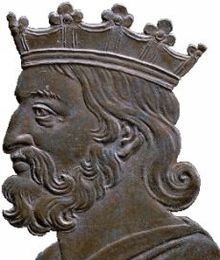Dagobert I

Dagobert I (c. 603 – 19 January 639) was the king of Austrasia (623–634), king of all the Franks (629–634), and king of Neustria and Burgundy (629–639). He was the last Merovingian dynast to wield any real royal power. Dagobert was the first of the French kings to be buried in the royal tombs at Saint Denis Basilica.
Rule in Austrasia
Dagobert was the eldest son of Chlothar II and Haldetrude (575-604). Chlothar II had reigned alone over all the Franks since 613. In 623, Chlothar was forced to make Dagobert king of Austrasia by the nobility of that region, who wanted a king of their own.
When Chlothar II granted Austrasia to Dagobert, he initially excluded Alsace, the Vosges, and the Ardennes, but shortly thereafter the Austrasian nobility forced him to concede these regions to Dagobert. The rule of a Frank from the Austrasian heartland tied Alsace more closely to the Austrasian court. Dagobert created a new duchy (the later Duchy of Alsace) in southwest Austrasia to guard the region from Burgundian or Alemannic encroachments and ambitions. The duchy comprised the Vosges, the Burgundian Gate, and the Transjura. Dagobert made his courtier Gundoin the first duke of this new polity that was to last until the end of the Merovingian dynasty.
United rule
On the death of his father in 629, Dagobert inherited the Neustrian and Burgundian kingdoms. His half-brother Charibert, son of Sichilde, claimed Neustria but Dagobert opposed him. Brodulf, the brother of Sichilde, petitioned Dagobert on behalf of his young nephew, but Dagobert assassinated him and gave his younger sibling Aquitaine.

Charibert died in 632 and his son Chilperic was assassinated on Dagobert's orders. By 632, Dagobert had Burgundy and Aquitaine firmly under his rule, becoming the most powerful Merovingian king in many years and the most respected ruler in the West.
In 631, Dagobert led three armies against Samo, the rulers of the Slavs, but his Austrasian forces were defeated at Wogastisburg.
Rule in Neustria, from Paris

Also in 632, the nobles of Austrasia revolted under the mayor of the palace, Pepin of Landen. In 634, Dagobert appeased the rebellious nobles by putting his three-year-old son, Sigebert III, on the throne, thereby ceding royal power in the easternmost of his realms, just as his father had done for him eleven years earlier.
As king, Dagobert made Paris his capital. During his reign, he built the Altes Schloss in Meersburg (in modern Germany), which today is the oldest inhabited castle in that country. Devoutly religious, Dagobert was also responsible for the construction of the Saint Denis Basilica, at the site of a Benedictine monastery in Paris.
Dagobert died in the abbey of Saint-Denis and was the first French king to be buried in the Saint Denis Basilica, Paris.
Legacy
The pattern of division and assassination which characterise even the strong king Dagobert's reign continued for the next century until Pepin the Short finally deposed the last Merovingian king in 751, establishing the Carolingian dynasty. The Merovingian boy-kings remained ineffective rulers who inherited the throne as young children and lived only long enough to produce a male heir or two, while real power lay in the hands of the noble families who exercised feudal control over most of the land.

Dagobert was immortalized in the song Le bon roi Dagobert (The Good King Dagobert), a nursery rhyme featuring exchanges between the king and his chief adviser, Saint Eligius (Eloi in French). The satirical rhymes place Dagobert in various ridiculous positions from which Eligius' good advice manages to extract him. The text, which probably originated in the 18th century, became extremely popular as an expression of the anti-monarchist sentiment of the French Revolution. Other than placing Dagobert and Eligius in their respective roles, it has no historical accuracy.
In 1984, a 112-minute long French-Italian comedy, Le bon roi Dagobert (Good King Dagobert) was made, based on Dagobert I. The movie is surprisingly realistic in showing the realities of early barbarian France. The soundtrack was composed by Guido and Mauricio De Angelis.
According to the Dan Brown novel The Da Vinci Code, King Dagobert was a descendant of Jesus Christ and Mary Magdalene.
Marriage and issue
Dagobert was a serial monogamist.
He married Nanthild and they had the following:
- Clovis II, who inherited the rest of his kingdom at a young age when his father died.
- Regintrud who married into the Bavarian Agilolfings, either Theodo, Duke of Bavaria or his son Duke in Salzburg.
He also had a mistress named Ragintrudis (Ragnetrude) and they had the following:
His other wives were:
- Wulfefundis (Wulfegunde)
- Bertechildis (Berthilde)
- Gomentrude
Source


